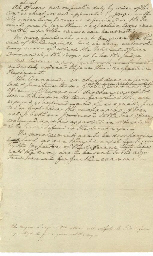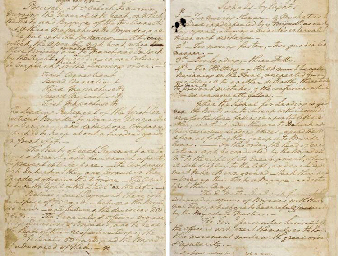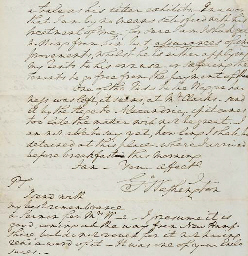WASHINGTON, George. Autograph "Order of Battle" for the Continental Army's Light Infantry, the advance Corps for a projected assault on New York, to be commanded by the Marquis de Lafayette, titled on verso by Washington "Order of Battle," [Peekskill, N.Y.], 1 August 1780. 1 page, 4to, neatly drawn in ink . Verso docketed and dated by Washington; with a bold later inscription "Washington's Handwriting Jared Sparks" (see provenance). Washington's neatly drawn schematic shows 14 unit markers in the form of shields or armorial bearings, each with a band at top shaded, the unit commander's name noted beneath; curving ink lines connect the different units into corps, these are further divided into Left and Right wings; where they intersect at the bottom, Washington has indicated his own position as the army's "Comm r. in Chief." WASHINGTON'S AUTOGRAPH "ORDER OF BATTLE" FOR THE CAMPAIGN TO RETAKE NEW YORK FROM THE BRITISH: THE ONLY WASHINGTON ORDER OF BATTLE IN PRIVATE HANDS An exceedingly rare autograph plan, carefully diagrammed by the Commander-in-Chief himself, for an intended campaign, long hoped-for by Washington, that never took place: the Continental Army's direct assault on the city and garrison of New York, British headquarters since its evacuation by Washington's army in the Fall of 1776. Although Washington had by 1780 suffered a number of painful defeats, no single loss--even that of Philadelphia--rankled and angered him as did the loss of New York. Control of the city gave the British an invaluable staging area for attacking southward, as well as ready naval access via the Hudson River to the interior of New England. In late July 1780, a French expeditionary force, commanded by the Comte de Rochambeau and accompanied by the Marquis de Lafayette, landed in Newport, Rhode Island. Word was immediately passed to Washington. The English Navy moved quickly to blockade the French squadron in harbor, and, soon afterwards, British General Henry Clinton and a sizeable body of troops embarked on transports from New York, evidently with the intention of engaging the French-American forces at Newport. Washington saw the temporary weakening of the New York garrison as a tempting tactical opportunity and put in motion long-laid plans for a major campaign--with French support--to retake the city. "These allies were not to content themselves with half measures," notes Washington biographer Douglas Freeman ( Washington , 5:161). Preparations were energetic: militia units were urgently summoned to the New York Highlands, munitions stockpiled and hundreds of siege ladders secretly built. Washington himself carefully planned the disposition, arrangement and command of his carefully husbanded forces. In recognition of his services to the American cause, Washington gave Lafayette command of the attack force. On July 27, Washington reported to the Marquis (then in Connecticut) that "Clinton still continues to threaten your country men...I have put the troops here under marching orders...If Clinton moves in force to Rhode Island we may possibly be able to take advantage of it, or we may embarrass him a little...In this case there are only two things that would hinder us taking New York before you return; the want of men and arms to do it with..." (Fitzpatrick 19:270). He wrote on 1 August to Governor Livingston, urgently requesting more troops (Fitzpatrick 19:292). The same day, to Governor Trumbull, requesting militia, Washington spelled out his plans: "I am assembling our whole Continental force at this place with an intent to move down towards New York, in hopes that an opportunity may offer in the absence of Sir Henry Clinton of striking the enemy to advantage or at least of gaining possession of some posts which will be of very great advantage in carrying on our future operations..." (Fitzpatrick, 19:291). In Washington's Order of Battle, overall command is to rest with the young Marquis de Lafayette, at the head of two brigades (s
WASHINGTON, George. Autograph "Order of Battle" for the Continental Army's Light Infantry, the advance Corps for a projected assault on New York, to be commanded by the Marquis de Lafayette, titled on verso by Washington "Order of Battle," [Peekskill, N.Y.], 1 August 1780. 1 page, 4to, neatly drawn in ink . Verso docketed and dated by Washington; with a bold later inscription "Washington's Handwriting Jared Sparks" (see provenance). Washington's neatly drawn schematic shows 14 unit markers in the form of shields or armorial bearings, each with a band at top shaded, the unit commander's name noted beneath; curving ink lines connect the different units into corps, these are further divided into Left and Right wings; where they intersect at the bottom, Washington has indicated his own position as the army's "Comm r. in Chief." WASHINGTON'S AUTOGRAPH "ORDER OF BATTLE" FOR THE CAMPAIGN TO RETAKE NEW YORK FROM THE BRITISH: THE ONLY WASHINGTON ORDER OF BATTLE IN PRIVATE HANDS An exceedingly rare autograph plan, carefully diagrammed by the Commander-in-Chief himself, for an intended campaign, long hoped-for by Washington, that never took place: the Continental Army's direct assault on the city and garrison of New York, British headquarters since its evacuation by Washington's army in the Fall of 1776. Although Washington had by 1780 suffered a number of painful defeats, no single loss--even that of Philadelphia--rankled and angered him as did the loss of New York. Control of the city gave the British an invaluable staging area for attacking southward, as well as ready naval access via the Hudson River to the interior of New England. In late July 1780, a French expeditionary force, commanded by the Comte de Rochambeau and accompanied by the Marquis de Lafayette, landed in Newport, Rhode Island. Word was immediately passed to Washington. The English Navy moved quickly to blockade the French squadron in harbor, and, soon afterwards, British General Henry Clinton and a sizeable body of troops embarked on transports from New York, evidently with the intention of engaging the French-American forces at Newport. Washington saw the temporary weakening of the New York garrison as a tempting tactical opportunity and put in motion long-laid plans for a major campaign--with French support--to retake the city. "These allies were not to content themselves with half measures," notes Washington biographer Douglas Freeman ( Washington , 5:161). Preparations were energetic: militia units were urgently summoned to the New York Highlands, munitions stockpiled and hundreds of siege ladders secretly built. Washington himself carefully planned the disposition, arrangement and command of his carefully husbanded forces. In recognition of his services to the American cause, Washington gave Lafayette command of the attack force. On July 27, Washington reported to the Marquis (then in Connecticut) that "Clinton still continues to threaten your country men...I have put the troops here under marching orders...If Clinton moves in force to Rhode Island we may possibly be able to take advantage of it, or we may embarrass him a little...In this case there are only two things that would hinder us taking New York before you return; the want of men and arms to do it with..." (Fitzpatrick 19:270). He wrote on 1 August to Governor Livingston, urgently requesting more troops (Fitzpatrick 19:292). The same day, to Governor Trumbull, requesting militia, Washington spelled out his plans: "I am assembling our whole Continental force at this place with an intent to move down towards New York, in hopes that an opportunity may offer in the absence of Sir Henry Clinton of striking the enemy to advantage or at least of gaining possession of some posts which will be of very great advantage in carrying on our future operations..." (Fitzpatrick, 19:291). In Washington's Order of Battle, overall command is to rest with the young Marquis de Lafayette, at the head of two brigades (s















Try LotSearch and its premium features for 7 days - without any costs!
Be notified automatically about new items in upcoming auctions.
Create an alert